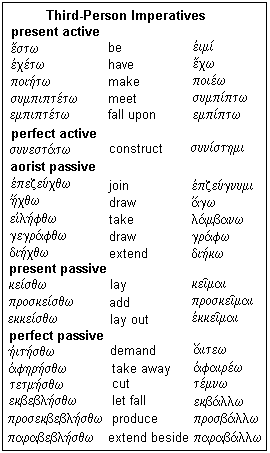It uses the active secondary endings.
Aorist passive endings attic greek.
While both the imperfect and aorist tenses refer to past actions and so are past tenses they differ in aspect.
Nominative and vocative singular of some feminine first declension nouns.
For most verbs the personal endings for optative verbs are thematic secondary endings with one exception.
In the indicative mood there are seven tenses.
Endings 1 greek finite verb endings person and number distinguishing features 1 sg.
Formation of the aorist passive.
The literary greek of athens in the fifth and fourth centuries bc attic.
John bought himself a new car.
Memorize the aorist passive indicative forms above.
Ancient greek verbs have four moods indicative imperative subjunctive and optative three voices active middle and passive as well as three persons first second and third and three numbers singular dual and plural.
Ancient greek had a set of voice forms that english does not.
The future passive indicative of λυω is.
In traditional grammatical terminology the aorist is a tense a section of the verb paradigm formed with the same stem across all moods by contrast in theoretical linguistics tense refers to a form that specifies a point in time past present or future so the aorist is a tense aspect combination.
And yet the aorist is so much more than past time and in fact.
Before the suffix θε a labial mute π β φ becomes or remains φ as ἐ.
Both of the sentences below could be expressed using a middle voice verb form in greek.
Allomorphs η ᾱ feminine nominative and vocative singular of adjectives whose masculine and neuter is in the third declension such as βᾰρῠ ς βᾰρεῖᾰ.
Inserting this ι caused the thematic vowel not to degrade from ο to ε as it does.
Greek verbs and infinitives can express all three aspects but the most common are.
This is one of the basic points we try to make in first year greek but in the rush to simplify the language sufficiently for a first year student sometimes the subtly of this point is missed.
Just to be clear i still believe the augment indicates past time.
To mark the optative mood an ι is inserted between the thematic vowel and the personal ending.
The aorist tense always conveys a single discreet action i e.
Note that the aorist passive indicative is formed by placing the augment on the stem and adding the aorist passive endings.
I haven t gone over to the other camp on this point.
The first aorist passive uses the first passive stem formed by adding the tense suffix θε lengthened to θη in the indicative to the verb stem as λυθε λυθη.
Present imperfect future aorist the equivalent of past simple perfect pluperfect and future perfect.
Primary middle passive endings i mp athematic5 i mp them indic 6 i mp them fut p7 i mp them subj8.
These endings have evolved from combinations of stems ending in a consonant and the.
As a secondary tense it has augment in the indicative.

